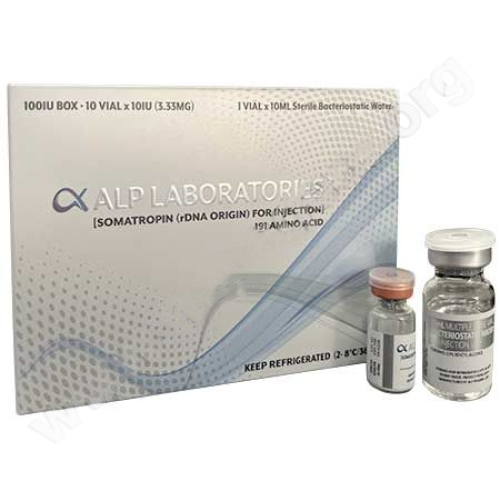Somatropin 100iu (ALP Laboratories)
- Brand: ALP Laboratories
- Product Code: Somatropin 100iu (ALP Laboratories)
- Availability: In Stock
-
$330.00
Manufacturer: ALP Laboratories
Pharmaceutical name: Somatropin
Pack: 1 kit (10 vials (100iu/kit))
One kit includes 10 vials of Somatropin at 100iu each, along with Bacteriostatic Water.
Somatropin, like natural growth hormone (GH), attaches to dimeric GH receptors on the cell membranes of target cells, initiating intracellular signaling and various pharmacodynamic effects. Many of these effects are primarily mediated by IGF-I generated in the liver and locally (for instance, in skeletal development and protein synthesis), while others result mainly from the direct actions of somatropin (such as lipolysis).
In humans, growth hormone is generated by the pituitary gland and is particularly elevated during adolescence, facilitating tissue growth, protein accumulation, and the breakdown of subcutaneous fat reserves. After maturation, the levels of endogenous GH decline, but they remain present in the body at significantly lower levels. The actual structure of growth hormone consists of a chain of 191 amino acids. After its isolation, many scientists believed this hormone would exhibit remarkable therapeutic benefits, particularly in treating pituitary dwarfism, possibly restoring considerable linear growth when administered during childhood.
The utilization of HGH powder
The use of growth hormone is increasingly popular among athletes due to its various associated benefits. Primarily, GH promotes an increase in overall body tissues, which is usually due to a rise in cell number rather than size. This affects skeletal muscles and, except for the eyes and brain, all other body organs. The transport of amino acids and the rate of protein synthesis also increase, which are both mediated by IGF-1 (insulin-like growth factor), a powerful anabolic hormone produced in the liver and other tissues in response to growth hormone, peaking around 20 hours after HGH administration.
Growth hormone also stimulates the breakdown of triglycerides in adipose tissue, typically leading to significant fat loss during treatment. Furthermore, GH enhances glucose production in the liver and induces insulin resistance by inhibiting this hormone's activity in target cells, resulting in a shift where fat becomes a more primary fuel source, further promoting fat loss.
Impact on the organism
Its growth-promoting effects also appear to strengthen connective tissues, cartilage, and tendons, potentially reducing the risk of injury (especially during heavy weight training) and enhancing lifting capacity (strength). HGH is also considered a safe substance in drug tests.
Although its use is prohibited by sports organizations, no reliable detection method exists, making it attractive to (among others) professional bodybuilders, strength athletes, and Olympic competitors who may use this drug during competition.
There are discussions that a reliable test for exogenous growth hormone administration has been developed and is close to implementation. Until then, growth hormone will remain a highly sought-after substance for athletes. However, the extent to which HGH is effective for an athlete has been the subject of ongoing debate. Some claim it to be the ultimate anabolic substance, capable of extraordinary muscle gain and rapid fat loss.
The fact that it is primarily used by serious competitors able to afford this expensive drug adds to the mythos surrounding HGH. Many confidently assert that the impressive muscle mass of Olympic athletes each year results entirely from HGH usage.
Conversely, some in the bodybuilding community argue that it is a complete waste of money, ineffective as an anabolic agent, and provides minimal fat loss, presenting it as a poor investment compared to steroids. Thus, a wide range of opinions about this drug exists; whom should we believe?
How to use HGH powder
The average male athlete typically requires a dosage in the range of 4 to 6 i.u. daily to achieve optimal results. At the lower end, 1 to 2 i.u. may still be significant. Daily dosing is crucial since HGH has a very short lifespan in the body.
Peak blood levels are observed shortly (2 to 6 hours) after injection, with the hormone cleared from the body having a half-life of only 20-30 minutes. As such, it doesn’t remain in the system for long, making it challenging to maintain stable blood levels. The effects of this drug are most pronounced when used for extended periods, often several months.
Some do use it for shorter durations, mainly when targeting fat loss, which typically involves a cycle of at least four weeks. This compound can be administered through both intramuscular and subcutaneous injections. "Sub-q" injections are particularly noted for promoting localized fat loss, requiring users to frequently change injection sites to ensure even effects. A general loss of fat seems to be the one feature most users agree upon. The fat-burning properties of this drug appear to manifest more quickly and are less reliant on high doses.

